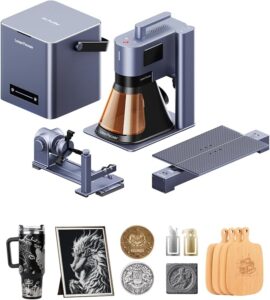LaserPecker is a compact and portable laser engraving machine popular among hobbyists and small businesses. Its user-friendly interface and versatile capabilities make it a favorite choice for engraving a variety of materials. However, when it comes to engraving metal, there are specific considerations to keep in mind.
In this article, we’ll explore whether the LaserPecker can engrave metal, what techniques may be required, and everything you need to know before using it for metal engraving.
Table of Contents
Can A LaserPecker Engrave Metal?
Yes, a LaserPecker can engrave metal, but it depends on the type of metal and the specific LaserPecker model. The LaserPecker series primarily uses diode lasers, less powerful than CO2 or fiber lasers. As a result, they may not engrave bare or uncoated metals directly without additional preparation.
Any LaserPecker that does not include the 1064nm Infrared Laser or the latest LP5 20W Fiber Laser will require metals to be pretreated for engraving. See the table below for detailed information:
Laser Model | Metal Engraving Pretreatment |
|---|---|
LaserPecker LX1 – 10W and 20W Blue Diode Laser | Required |
LaserPecker LX1 – 10W and 20W Blue Diode Laser + 2W 1064nm Infrared Laser | Not Required |
LaserPecker 1 Pro – 5W Blue Diode Laser | Required |
LaserPecker 2 – 5W Blue Diode Laser | Required |
LaserPecker 3 – 1W 1064nm Infrared Laser | Not Required |
LaserPecker 4 – 10W Blue Diode Laser + 2W 1064nm Infrared Laser | Not Required |
LaserPecker 5 – 20W Fiber Laser + 20W Diode Laser | Not Required |
Engraving Bare Metal
Diode lasers, like those used in LaserPecker devices, are not inherently capable of engraving bare metals because their wavelength doesn’t interact strongly with metallic surfaces. However, you can achieve engraving on bare metals using special marking solutions:
- Metal Marking Sprays or Pastes: Products like Brilliance Laser Inks can be applied to the metal surface. The LaserPecker heats the coating during engraving, leaving a permanent mark on the metal.
Brilliance Laser Inks 12 Oz Laser Marking Spray – Black (BLI101)
Metal Compatibility: Uncoated surfaces such as stainless steel, brass, copper, pewter, and other metal materials
Laser Compatibility: CO2 lasers (minimum 25 watts), Fiber/YAG lasers (minimum 10 watts), and Diode lasers (minimum 10 watts)
Engraving Coated or Anodized Metal
LaserPecker excels at engraving coated or anodized metals. The laser removes the coating to reveal the underlying material, creating clean and precise designs.
- Examples: Anodized aluminum, painted steel, or powder-coated metals.
- Applications: Customizing phone cases, nameplates, and metal tags.
Types of Metal Compatible with LaserPecker
- Anodized Aluminum: Engraves cleanly by removing the anodized layer.
- Painted or Coated Metals: Works well by removing the top layer to reveal the base metal.
- Stainless Steel with Marking Spray: Produces durable marks with the right coating.
Settings for Metal Engraving with LaserPecker
To achieve the best results, you need to optimize the LaserPecker’s settings:
- Power: Set the power to the maximum level for stronger engravings.
- Speed: Use slower speeds to allow the laser to heat the surface adequately.
- Focus: Ensure the laser is correctly focused for precise marking.
- Preparation: Apply marking spray or ensure the coated surface is clean and flat.
Tips for Engraving Metal with LaserPecker
- Use a Jig or Fixture: Keep the metal steady to avoid shifting during engraving.
- Test Settings: Experiment on scrap material to find the optimal combination of speed, power, and focus.
- Ventilation: Ensure proper ventilation to avoid inhaling fumes from marking sprays or coatings.
When to Consider a More Powerful Laser
If you require deep engraving or frequent work with bare metals, consider investing in the LaserPecker 5 with a 20W fiber laser and 20W blue diode laser. The fiber laser is specifically designed for metal engraving and provides faster, deeper, and more consistent results.
Comparison Table of LaserPecker Models with Material Compatibility
Model | Laser Type | Power | Materials It Can Engrave | Key Features |
|---|---|---|---|---|
LaserPecker LX1 (10W) | Blue Diode Laser | 10W | Wood, Paper, Cardboard, Leather, Acrylic, Coated/Anodized Metal (no bare metal), Glass with coating or spray | Compact design, suitable for hobbyists, limited to non-metal or coated surfaces. |
LaserPecker LX1 (20W) | Blue Diode Laser | 20W | Wood, Paper, Cardboard, Leather, Acrylic, Coated/Anodized Metal, Glass with coating or spray | Higher power for faster and deeper engraving compared to the 10W model. |
LaserPecker LX1 (10W & 20W) with 2W Infrared Laser Module | Blue Diode + Infrared Laser (1064nm) | 10W or 20W + 2W | All materials from above plus bare metals (e.g., stainless steel, aluminum), certain plastics, jewelry | Dual-laser versatility; engraves bare metals and expands material options for professional use. |
LaserPecker 1 Pro (5W) | Blue Diode Laser | 5W | Wood, Paper, Cardboard, Leather, Acrylic, Coated/Anodized Metal, Glass with coating or spray | Lightweight and portable, best for simple designs on non-metal or coated surfaces. |
LaserPecker 2 (5W) | Blue Diode Laser | 5W | Wood, Paper, Cardboard, Leather, Acrylic, Coated/Anodized Metal, Glass with coating or spray | Faster engraving speed than LaserPecker 1 Pro, supports larger work areas. |
LaserPecker 3 (1W) | Infrared Laser (1064nm) | 1W | Bare Metals (e.g., stainless steel, aluminum), Jewelry, Certain Plastics | Specializes in fine details on bare metals and plastics; low power, slower processing. |
LaserPecker 4 (10W + 2W) | Blue Diode Laser (10W) + Infrared Laser (2W) | 10W + 2W | Combines capabilities of LX1 and LP3: All non-metal materials, Coated/Anodized Metal, Bare Metals, Jewelry, Glass | Versatile, high-power dual-laser system; ideal for professionals and advanced hobbyists. |
LaserPecker 5 (20W + 20W) | Fiber Laser (20W) + Blue Diode Laser (20W) | 20W + 20W | All non-metal materials, while the fiber laser can engrave on all metals (stainless steel, aluminum, gold, silver, iron, platinum) and plastic. | Versatile, high-power dual laser system: ideal for professionals. |
Key Insights
- Versatility: Models with dual lasers (LX1 with 2W infrared or LP4 and LP5) are the most versatile, handling bare metals and non-metals alike.
- Specialized Engraving: Infrared-only models like the LP3 excel at precision on metals and plastics but are less effective for general materials like wood or acrylic.
- Power Comparison: Higher power (e.g., 20W LX1) enables deeper, faster engraving but is still limited for bare metal without an infrared module or 20W fiber laser module.
- Portability: The LP1 Pro and LP2 prioritize portability and ease of use for beginners or hobbyists.
Each model serves distinct needs, with the LP5 being the most advanced and versatile, suitable for those who need to engrave a wide range of materials, including bare metals.
A LaserPecker With The 1064nn Infrared Laser Can Engrave Metal Directly
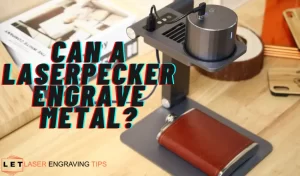
Laser engraving is a versatile and precise method for etching designs or text onto various materials, and metal is no exception. However, not all lasers can engrave metal directly, especially without pretreatment.
The LaserPecker series, specifically those equipped with a 1064nm infrared laser, have emerged as a solution for direct metal engraving.
Understanding the 1064nm Infrared Laser
LaserPecker models that include the 1064nm infrared laser, such as the LaserPecker LX1, LaserPecker 3, and LaserPecker 4, are particularly effective for engraving metal directly without the need for pretreatment. The 1064nm wavelength is ideal for metals because it can interact with the material’s surface, creating clear and lasting marks.
This capability sets the infrared laser apart from blue diode lasers, which often require metal surfaces to be treated with marking agents or other methods before engraving.
How the LaserPecker 1064nm Infrared Laser Works on Metal
Infrared lasers like the 1064nm version work by emitting a concentrated beam of light that is absorbed by metal surfaces. This interaction causes localized heating, which removes material from the surface or changes its color, allowing for precise engraving. The result is a sharp, high-contrast design or text that is highly durable.
LaserPecker models with this technology allow users to engrave a wide variety of metals, including:
- Stainless steel
- Aluminum
- Brass
- Gold and silver (for marking)
These lasers can engrave directly onto metal surfaces without additional steps, making them a more efficient choice for users who frequently work with metals.
Benefits of Engraving Metal with a 1064nm Infrared Laser
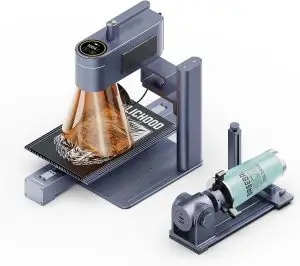
- No Pretreatment Required: Unlike blue diode lasers, which need pretreatment (e.g., using marking sprays or coatings), the 1064nm infrared laser engraves metals directly, saving time and effort.
- Precision and Clarity: The 1064nm wavelength provides high accuracy in engraving, making it perfect for detailed work, from intricate designs to text.
- Durability: Metal engravings created with this laser are long-lasting and resistant to wear, ensuring that the design remains intact even with extended use.
Suitable LaserPecker Models for Direct Metal Engraving
- LaserPecker LX1 – 10W and 20W Blue Diode Laser + 2W 1064nm Infrared Laser: Metals can be engraved directly.
- LaserPecker 3 with 1W 1064nm Infrared Laser On Amazon: Offers the capability to engrave metal surfaces without pretreatment.
- LaserPecker 4 with 10W Blue Diode Laser and 2W 1064nm Infrared Laser On Amazon: Ideal for direct metal engraving and enhanced flexibility for other materials.
- LaserPecker 5 with 20W Fiber Laser and 20W Blue Diode Laser On Amazon: The ultimate laser for direct metal engraving and enhanced flexibility for other materials.
How Can A LaserPecker Without The 1064nm Infrared Laser Engrave Metal Directly?
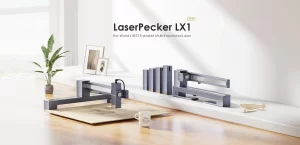
LaserPecker is known for offering a range of compact and versatile laser engravers that cater to different engraving needs. However, not all models in the LaserPecker lineup are equipped with the 1064nm infrared laser or the latest 20W fiber laser module, which is optimized for directly engraving metal.
For those without this laser, engraving metal requires a few additional steps or treatments to achieve the desired results.
Why Blue Diode Lasers Can’t Engrave Metal Directly
Most LaserPecker models without the 1064nm infrared laser or 20W fiber laser module, such as the LaserPecker 1 Pro, LaserPecker 2, and even the standard 10W or 20W blue diode lasers, are not capable of engraving metal directly. Blue diode lasers are typically more suited for materials like wood, leather, and acrylic, but struggle with untreated metal because:
- Reflectivity of Metal: Metals reflect much of the laser light emitted by blue diode lasers, which reduces the energy absorbed by the metal’s surface and makes it difficult to create permanent engravings.
- Insufficient Power Absorption: Blue diode lasers have difficulty heating the surface of the metal enough to engrave it without special preparation.
However, there are ways to engrave metal using these blue diode laser models by applying specific treatments or using techniques to enhance the laser’s effectiveness on metal surfaces.
How to engrave Metals with a LaserPecker Using Brilliance Laser Inks
Laser engraving on metals with a LaserPecker becomes more accessible and precise when combined with Brilliance Laser Inks. This innovative marking solution is designed to enhance the capabilities of lower-power laser engravers like the LaserPecker models. This guide will walk you through engraving metals effectively.
Why Use Brilliance Laser Inks for Metal Engraving?
Brilliance Laser Inks are specially formulated to enable clear, durable marks on bare metals using lasers that typically struggle with direct metal engraving. The ink bonds with the metal surface during the engraving process, leaving a permanent and high-contrast mark. This is ideal for applications like personalization, branding, or industrial tagging.
Materials You’ll Need:
- LaserPecker engraver (preferably a model with a 10 Watt module for best results)
- Brilliance Laser Ink (available for different metals like stainless steel, aluminum, brass, etc.)
- Metal surface (e.g., stainless steel, aluminum, brass)
- Clean, lint-free cloth
- Isopropyl alcohol
- Heat-resistant gloves (optional for safety)
Brilliance Laser Inks 12 Oz Laser Marking Spray – Black (BLI101)
Metal Compatibility: Uncoated surfaces such as stainless steel, brass, copper, pewter, and other metal materials
Laser Compatibility: CO2 lasers (minimum 25 watts), Fiber/YAG lasers (minimum 10 watts), and Diode lasers (minimum 10 watts)
Step-by-Step Guide to Engrave Metals with Brilliance Laser Inks
Prepare the Metal Surface
- Clean the metal surface thoroughly using isopropyl alcohol and a lint-free cloth.
- Remove any dust, grease, or debris to ensure the ink adheres properly.
Apply the Brilliance Laser Ink

- Shake the Brilliance Laser Ink container well to mix the contents evenly.
- Apply a thin, even layer of ink onto the metal surface.
- Allow the ink to dry completely. This typically takes 2-5 minutes, depending on the environmental conditions.
Set Up Your LaserPecker Engraver
- Position your LaserPecker above the metal surface. Ensure that the engraving area is aligned with the ink-covered section.
- Adjust the focus according to your LaserPecker model’s guidelines. Proper focus is critical for optimal results.
Configure the Laser Settings
- Set the laser power, speed, and resolution based on the recommendations for Brilliance Laser Inks and the type of metal you are using.
- Suggested Starting Settings:
- Power: 100%
- Speed: Moderate to Slow (depends on your LaserPecker model)
- Line Spacing: Tight for better detail
- Suggested Starting Settings:
- Perform a test engraving on a small, inconspicuous area if possible.
Begin the Engraving Process
- Start the engraving process using your LaserPecker’s software or mobile app.
- Monitor the process to ensure the laser is marking correctly and to make adjustments if needed.
Clean the Engraved Surface
- Once engraving is complete, clean off any remaining Brilliance Laser Ink residue using a damp cloth or isopropyl alcohol.
- Gently rub the surface to reveal the crisp, permanent engraving.
Tips for Best Results
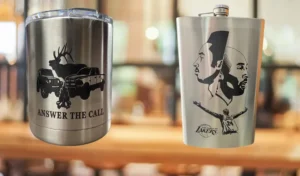
- Optimize Settings: Test various laser settings to achieve the best contrast and clarity.
- Work in a Well-Ventilated Area: Ensure proper ventilation when using laser engravers and inks.
Why Use LaserPecker with Brilliance Laser Inks?
LaserPecker engravers are compact and versatile tools. However direct engraving capabilities on metals with models without the infrared laser module or the 20W fiber laser module is not possible. By pairing them with Brilliance Laser Inks, you can unlock professional-grade engraving potential for a fraction of the cost of high-power fiber lasers.
What Can the LaserPecker LP5 – The Smart 20W Fiber + 20W Diode Laser Engrave?
The LaserPecker LP5 is a groundbreaking laser engraving machine that combines a powerful 20W diode laser with a 20W fiber laser, making it an incredibly versatile tool for a wide range of engraving applications. Whether you’re a hobbyist, small business owner, or professional engraver, the LP5’s advanced dual-laser technology enables it to handle a variety of materials with exceptional precision. Here’s a detailed look at the materials the LP5 can engrave and its unique capabilities.
Materials the LaserPecker LP5 Can Engrave
Metals
The LP5’s 20W fiber laser is specifically designed to engrave metals, making it a standout choice for those working with:
- Types: Stainless steel, aluminum, titanium, brass, copper, and coated metals like anodized aluminum.
- Applications: Jewelry, tools, industrial components, branding plates, and custom metal tags.
With its fiber laser, the LP5 provides deep, permanent engravings on bare metals without requiring marking agents.
Wood
The 20W diode laser in the LP5 excels at engraving various types of wood:
- Types: Softwoods, hardwoods, plywood, MDF, and bamboo.
- Applications: Custom furniture designs, art pieces, coasters, and signage.
The diode laser ensures clean cuts and detailed engravings, making it ideal for intricate wooden projects.
Plastics
The LP5 can engrave many types of plastics with its diode laser:
- Types: Dark Acrylic, ABS, PET, and other common plastic materials.
- Applications: Personalized phone cases, industrial labels, and promotional items.
Its dual-laser functionality allows for precise control to prevent melting or warping.
Glass
Engraving glass is another strong suit of the LP5’s diode laser:
- Types: Dark glass, frosted glass, and coated glass.
- Applications: Custom drinkware, decorative jars, and plaques.
For the best results, apply a masking material like transfer tape or use a damp paper towel to reduce heat-induced chipping.
Leather
The LP5’s diode laser performs exceptionally well on leather surfaces:
- Types: Genuine leather, PU leather, and suede.
- Applications: Custom wallets, belts, handbags, and keychains.
The diode laser allows for crisp and detailed designs on both synthetic and natural leather.
Stone and Ceramics
Engraving on stone and ceramic is possible with the LP5’s diode laser:
- Types: Slate, marble, granite, and glazed tiles.
- Applications: Personalized coasters, memorial plaques, and decorative tiles.
The LP5 provides stunning results, especially on dark, polished surfaces.
Fabrics and Paper
The LP5 is capable of engraving delicate materials with its adjustable power settings:
- Fabrics: Cotton, denim, and synthetic textiles.
- Paper: Craft paper, cardstock, and corrugated cardboard.
- Applications: Custom apparel, greeting cards, and unique packaging designs.
Key Features That Enhance Engraving Versatility
Dual-Laser Technology: The 20W diode laser is ideal for organic materials like wood and leather, while the 20W fiber laser is perfect for engraving metals and tougher surfaces.
- High-Speed Engraving: Capable of working quickly without compromising detail, making it efficient for both single projects and batch production.
- Compact and User-Friendly: Designed with ease of use in mind, the LP5 is suitable for beginners and professionals alike.
Why Choose the LaserPecker LP5?
The LP5 combines two powerful lasers in a single machine, eliminating the need for multiple devices for different materials. Its ability to engrave everything from metals and plastics to wood and glass makes it a versatile and cost-effective solution for creators, businesses, and hobbyists.
Whether you’re engraving intricate designs on jewelry, personalizing leather goods, or creating custom signage, the LaserPecker LP5 is an all-in-one powerhouse that delivers exceptional results across a broad range of materials.
Frequently Asked Questions
Does LaserPecker work on metal?
Yes, LaserPecker can work on metal, especially when paired with a marking solution like Brilliance Laser Inks or when using models equipped with a 1064nm infrared laser module or 20W fiber laser for direct metal engraving.
Can LaserPecker 2 cut metal?
No, the LaserPecker 2 cannot cut metal. It is primarily designed for engraving and works best on coated metals or with marking solutions for uncoated surfaces.
Can LaserPecker 2 engrave aluminum?
Yes, the LaserPecker 2 can engrave anodized or coated aluminum directly. For bare aluminum, you may need to use a marking spray like Brilliance Laser Inks.
Final Thoughts
Yes, LaserPecker devices can engrave metal, but the results depend on the model and the specific type of metal. While lower-powered LaserPecker models like the LP1 and LP2 can engrave coated or treated metals (such as anodized aluminum or painted surfaces), they lack the power to engrave bare metals directly. However, this can be achieved using marking agents like Brilliance Laser Inks.
For direct metal engraving without additional materials, the LaserPecker LP5 stands out as the ideal option. Equipped with a powerful 20W fiber laser, the LP5 is designed to handle bare metals like stainless steel, brass, and aluminum with precision and efficiency. If you’re looking to expand your metal engraving capabilities, the LP5 is a top choice that combines versatility and high performance.


